Ahoy the Mighty Macaws – the Pirate’s Favourite!
Mention the word parrot and the first thing many people think of is a Macaw. Sat abreast many a pirate’s shoulder in books, TV, films and cartoons, these colourful, long-tailed birds are big, beautiful, instantly recognisable as the archetypal parrot, and always happy to take a tasty treat from their owner.
Macaws are classified as New World Parrots which are native to South and Central America and the Caribbean Islands, along with small populations on the Pacific Islands such as the Galapagos. Generally, wild Macaw’s inhabit forest, particularly rainforest, although some types prefer woodland or even savannah-type habitats.
Types of Macaws
There are 19 species of Macaw. Tragically, in the wild, most of these are now critically endangered and some are extinct. This is principally due to rapid deforestation to provide land for agriculture, hunting, and trapping to supply the illegal pet trade.
However, populations of captive birds are relatively strong and reintroducing captive birds back into the wild to repopulate native habitats has been attempted in various parts of the world. This is a long process, however, with captive birds having to adapt to their surroundings slowly and the results of such reintroductions are not yet known.
The complete list of Macaws includes:
Blue and Yellow Macaw
This is the traditional pirate’s parrot and the same species at JJ, the Johnston & Jeff parrot. Blue and Yellow Macaws tend to have a blue back and wings and yellow neck and chest. They grow between 50 – 60cm tall (2.5 – 3 ft) and weigh around 1 – 1.2kg (2 – 2.5 pounds).
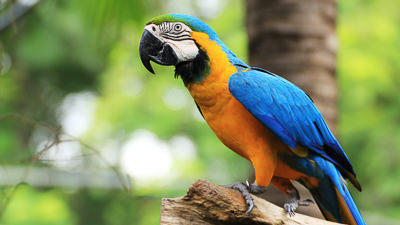
Blue and Yellow Macaws can live up to 70 years in captivity so are a big commitment if you’re considering get one as a pet. However, they are an extremely social and sweet natured which makes them great companions. They also have an incredible willingness to learn.
Scarlet Macaw
As the name suggests, the Scarlet Macaw is predominantly red in colour. They are of similar size and weight as the Blue and Yellow Macaw and tend to have a similar lifespan – 50 – 70 years.
They also tend to be a little more energetic than their Blue and Yellow cousins and are even considered a rebel by some.
Spix’s Macaw
The Spix’s Macaw is also called the Blue Macaw for obvious reasons. They are blue all over! The bird was made famous by the 2011 film Rio, in which a male Spix’s Macaw called Blu flew thousands of miles to save the last female Spix’s Macaw.
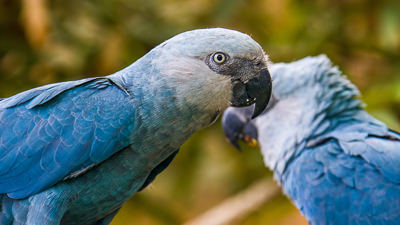
In captivity, the Spix’s Macaw stands around 60cm (2ft) tall and weighs around 0.5kg (one pound), putting them at the smaller end of the spectrum for Macaws. They live around 20 – 30 years.
In 2000, the Spix’s Macaw was sadly pronounced extinct, but the story doesn’t end there. In June 2022, the Association of Conservation of Threatened Parrots successfully reintroduced 52 birds back into the wild, in Brazil, so this attractive parrot may become a common site in its home country once again.
Hyacinth Macaw
Hyacinth Macaws are the largest member of the Macaw family and have a striking blue colour over the majority of their bodies but have a yellow ring around their eyes and a yellow outline to their beaks.
They are large parrots, standing 90 – 105cm (3 – 3.5ft) in height and weighing anywhere between 1.2 – 1.8kg (2.5 – 4 pounds). They have an average lifespan of 50 years.
Hyacinth Macaws are considered gentle giants and tend to have a calm and loving nature.
Red and Green Macaw
The Red and Green Macaw is a colour variant of the Blue and Yellow Macaw. As a result, they share a lot of common features including body size and weight, and their easy-going disposition.
However, one thing to bear in mind if considering one of these birds for a pet is that they live for up to 70 years, meaning you might need someone to leave the bird to, particularly if you’re buying it beyond the teenaged years!
Red Shouldered Macaw
This is one of the smallest Macaws, standing just 30cm (12 inches) or so high. They weigh just 140 – 170g (five – six ounces). They are predominately green in colour but have red patches on their shoulders.
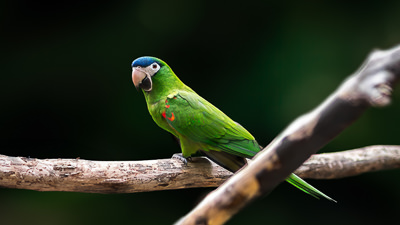
They have a lifespan of between 40 and 50 years and make charming and intelligent pets. So, if you’ve got your heart set on a Macaw but not enough space for one of the bigger varieties, this one might be for you.
Military Macaw
Despite their name, Military Macaws are gentle by nature and relatively tame. They grow up to around 105cm (3.5ft) in height and weigh around 1.2kg (2.5 pounds).
Military Macaws also have a long lifespan – up to 60 years – so that is something to consider if you’re attracted to this fine looking parrot.
Blue Throated Macaw
The Blue Throated Macaw is another colour variation of the Blue and Yellow Macaw. The two types are very similar looking, but as the name suggests, the Blue Throated Macaw has – you guessed it! – a blue throat.
One difference between the two though is lifespan. The Blue Throated Macaw can live as long as 80 years, making it a lifelong companion. It shares its disposition with its Blue and Yellow cousin, making it calm, good natured and loving.
Chestnut Fronted Macaw
These friendly, comical parrots are predominately green but with a hint of red and chestnut on their chests. They are typically smaller than most Macaws, measuring around 45cm (18 inches) tall and weighing around 0.3Kg (12 ounces).
Their lifespan can vary from 30 years to 80, depending on their overall health and the conditions in which they live. Chestnut Fronted Macaws are very sociable and bond well with their owner.
Great Green Macaw
The Great Green Macaw is a large parrot growing to around 90cm (3ft) tall and weighing on average 1.4kg (3 pounds). It is a mainly a light green colour, but has flecks of red and blue as well, making it a very attractive bird.
Great Green Macaws live for between 50 and 70 years so like a lot of the parrots on this list, they are a major commitment. They’re also very sociable with other birds and it is not advisable to keep them by themselves, so that is something to bear in mind if considering adopting one as a pet.
Blue Winged Macaw
Blue Winged Macaws are predominantly green with red and yellow specs across their body. However, as the name would suggest, they have blue wings.
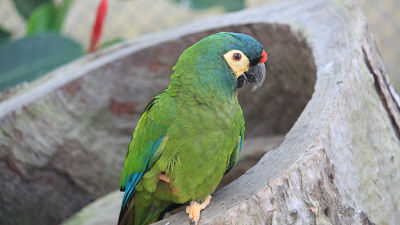
They are at the smaller end of the Macaw size range, measuring 35 – 45cm (14 – 17 inches) and weighing around 250g (9 ounces).
Typically, Blue Winged Macaws live for between 50 and 60 years, although some can live significantly longer. They are playful and friendly, and due to their size, many people consider them the perfect pet parrot.
Lear’s Macaw
The Lear’s Macaw is also known as the Indigo Macaw due to its dark blue colour. They can grow up to 90cm (3ft) in height and weigh between 1 – 1.2kg (2 and 2.5 pounds).
Lear’s Macaw live up to around 50 years old.
Red Fronted Macaw
Like many other Macaws, the Red Fronted Macaw has an almost entirely green body. However, the front of the head, leading from the crown to the top of the beak, is red, which is where its name derives from.
These attractive parrots are medium sized, growing to around 60cm (2ft) tall and weighing around 500g.
They are curious and can be mischievous, making them full of character and they typically live around 50 years.
Glaucous Macaw
Sadly, the Glaucous Macaw is listed by International Union for Conservation of Nature (IUCN) as ‘critically endangered, possibly extinct’ in the wild. They are large, charismatic birds that are greyish blue in colour.
In captivity, the Glaucous Macaw can come across as a large, dominant bird, but in actual fact they tend to be gentle and loving. In common with many other Macaws, they have a lifespan of around 50 years.
Golden Collared Macaw
Golden Collared Macaws are a relatively small bird for the Macaw family. They measure around 38 – 40cm (15 inches) high and weight 225 – 275g (8 to 10 ounces). Like many Macaws, their body is green but unsurprisingly, they have a golden collar.
They are affectionate and mischievous, making them a popular pet, and they live for around 50 years.
Red Bellied Macaw
Like the Golden-Collared Macaw, the Red Bellied Macaw is at the smaller end of the scale when it comes to Macaws. They usually measure around 35cm (14 inches) high and weigh about 300g (11 ounces).
They are quite rare as pets although some are bred in captivity. They are also very sociable and will only thrive if given a lot of attention by their owners. So, you must take that into consideration if you are thinking of adopting a Red Bellied Macaw into your life.
Blue Headed Macaw
Like many of the parrots on this list, the Blue-Headed Macaw is almost entirely green, except for a having – yes, you guessed it! – a blue head!
These are also among the smaller Macaws, standing just 38 – 40cm (15 or 16 inches) tall and weighing around 280 – 300g (10 – 11 ounces).
Blue-Headed Macaws are among the least sociable of the species. Whereas they do like human company, they often also choose to spend time by themselves.
Cuban Macaw
As you would expect from the name, the Cuban Macaw is native to the island of Cuba. Sadly, this highly colourful parrot became extinct in the wild in the 19th Century and therefore it is not possible to own them as pets.
Martinique Macaw
Unfortunately, the Martinique Macaw is another one that falls into the extinct category. These attractive birds were reported to be blue and orange, around 40 – 50cm (16 – 20 inches) tall and weighing about 350g (12 ounces).
However, it is believed they disappeared in the 17th Century, so it is safe to say, this is one Macaw you’re never going to own as a pet.
What do Macaws Eat?
Macaws of all types and sizes enjoy a varied diet. The best way to achieve this is to start with a fantastic quality base blend such as our Low Sunflower for Large Parrots or No.1 Parrot, which should constitute around 60 – 80 per cent of their nutritional needs. Then supplement this with either another high-quality blend, or individual ingredients.
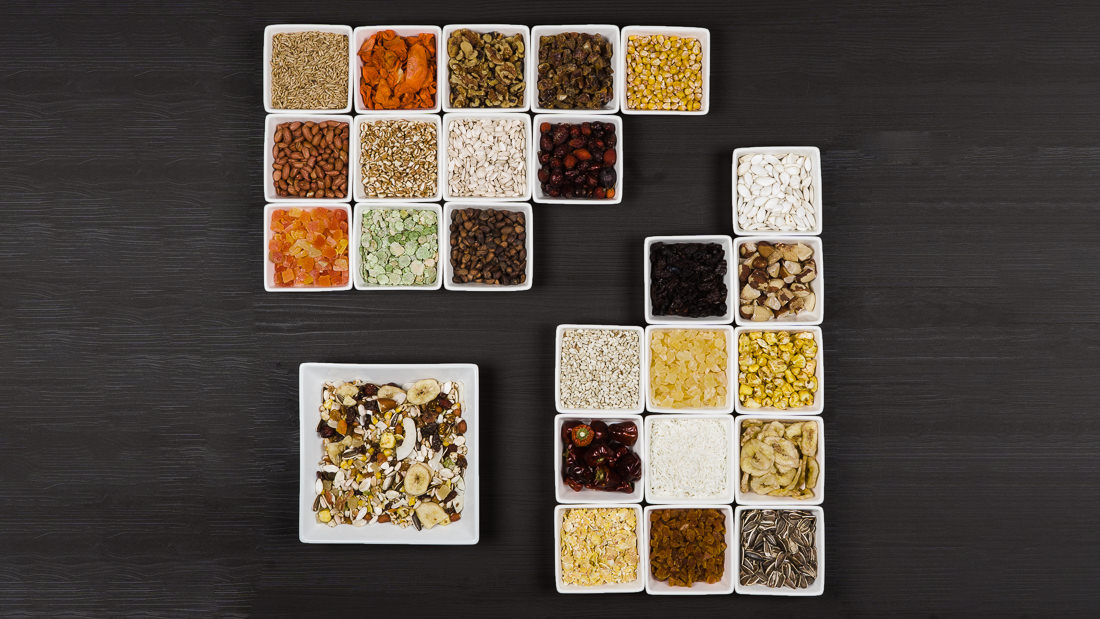
If you choose to supplement with another blend, choose something that has a large variety of tasty treats such as fruits, vegetables, and nuts. To help owners achieve this, we devised a formula that Macaws love called Fruit, Veg and Nut Mix. It contains a whole host of highly nutritious treats that when combined with the base blend, adds new tastes, essential vitamins and minerals, and provides enrichment through new colours, shapes, and textures.
Supplementing with Mixed Pulses is also great for Macaws. Pulses provide a low fat source of protein that helps with muscle repair and maintenance. However, always ensure you soak or boil your pulses before use.
Fruits and Berries
If you want to feed individual treats, chopped up fruit and vegetables work well because they packed with essential vitamins, fibre, minerals, and trace elements which will help keep your pet healthy for many years to come. However, be careful when feeding fruits. They contain a lot of sugar so fed in excess can lead to health issues, and some pips are toxic, particularly apple. So, if you do want to feed apple flesh to your birds, be sure to remove all traces of the pips.
Berries are also great. They contain high levels of health-boosting vitamin C and K, which improve your bird’s immune system to help fight off infection. However, also like fruit, berries contain a lot of sugar, so be careful not to feed too many.
Vegetables
Good vegetables to feed Macaws include fresh leaf veg such as lettuce, spinach, kale, and Swiss chard, as well as green beans, peppers, broccoli, carrots, cabbage, cauliflower, podded peas, sweetcorn, and sweet potato.
One thing to consider, however, when it comes to vegetables is that if they’re not organic or you haven’t grown them yourself, wash them. That way, you get rid of any harmful pesticides.
Seeds and Nuts
Quality base blends like Low Sunflower for Large Parrots or No.1 Parrot already contain nuts, so do you need to supplement with more seeds and nuts?
For seeds, the answer to that is probably no. Seeds, particularly sunflower seeds, can be addictive to all sorts of parrots, including Macaws, so adding these on top of the base blend is probably not needed. It is for this reason we created both our Low Sunflower for Large Parrots blend, and our Parrot Lean & Fit blend which contains no sunflower seeds or nuts, to ensure overfeeding and addiction doesn’t become a problem.
Nuts can be a fantastic addition to a Macaw’s diet and a real treat. They contain protein and lots of great minerals, including potassium, magnesium, calcium, zinc, and copper. Almonds, pistachios, peanuts, walnuts, and pecans are great to feed as a treat or a training aid.
However, if you decide to do this, you must take into account the extra calories you’re introducing into your bird’s diet, as nuts are packed with energy.
How Often Should I Feed My Macaw?
Macaws should be feed at least once a day. However, eating and mealtimes make for great bonding opportunities, and this is where treats can come in.
Treats can be used when engaging with your pet, particularly to train them to carry out practical tasks like letting you put your hand in to clean the enclosure or change the water, to fun tricks such as perching on your arm or climbing ladders.
By including treats, not only do you create a better bond with your parrot, you will also add variety into their diet, keeping them healthier and happier.

By adding half a cup of fresh fruits and vegetables to the base blend each day, you’ll ensure your Macaw gets all the nutrients he or she needs to enjoy a long and happy life.
Of course, always ensure there is fresh water on hand for your pet to drink, as this is important to ongoing health as well. Parrots also like to dunk their food, so make sure it is changed every day.
Macaw Enclosures
As Macaws are among the largest parrots, it’s no surprise they require a very big enclosure.
In fact, if you’re thinking about buying a Macaw, the top consideration needs to be do you have the space? So, before you decide whether a Macaw is for you or not, measure the room that is destined to be your pet’s home to see if it will accommodate an enclosure of the required size.
Regardless of the type of bird, an enclosure should be big enough for your bird to fully spread their wings and flap them freely. This means for a small Macaw such as a Golden-Collared or a Red-Bellied, the minimum dimensions of an enclosure should be 85cm (34 inches) wide, 60cm (24 inches) deep and 90cm (36 inches) tall.
For larger Macaws such as the Hyacinth, these measurements need to increase significantly. The minimum size for a large Macaw should be 90cm (36 inches) wide, 120cm (48 inches) deep and 150cm (60 inches) tall.
Another thing to consider is quality. A Macaw’s bite is strong and could bite through weak bars, so you should always buy the best quality enclosure you can afford.
As with all birds, it is vital when looking for an enclosure to make sure the bar spacing is doesn’t allow them to get their head through. This is because they can get it trapped, which could lead to tragic consequences, but also because Macaws are incredibly intelligent birds and will amuse themselves by trying to find ways of opening their enclosure and escaping!
Can Macaws Talk?
Most parrots are good mimics and can imitate human words to a lesser or greater extent. Macaws, being highly intelligent birds, are among the best parrot talkers.
Macaws will naturally start to mimic sounds they hear around the house as well as human words. However, you can also train your Macaw to talk. One way to do this is the start with food. When giving a treat, say the name of the treat (banana, seed, nut, etc) before allowing your parrot to have it. If your bird doesn’t repeat the word, say it again until they attempt to. Then give the treat.
Once the parrot has started to say the word, hold off from giving the treat until they refine the pronunciation. By continuing to do this, they’ll soon be speaking.
Also, parrots learn by association. If you always greet your pet with the word ‘Hello’, he or she will soon learn this is a greeting and say it back. Try the same when you leave, saying goodbye, and soon your Macaw will understand what this means and repeat it back to you.
Macaw Behaviour and Enrichment
Many parrot experts feel Macaws are more even-tempered than other, smaller types of parrot, and it is for this reason they can make fantastic pets. However, one thing Macaws really do crave is attention. They are very sociable birds.
So, the best enrichment you can give a Macaw is time and interaction. A lack of this may lead to stress, screaming, and destructive behaviours.
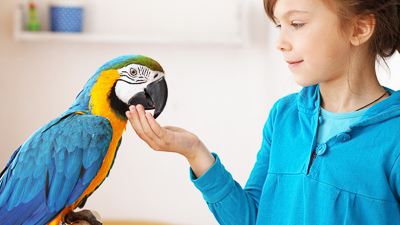
Allow your Macaw plenty of time out of its enclosure to ensure it can exercise and use all of its muscles, as this will help to keep it strong and in good health and enrich its environment with toys to play with to keep it busy when you are out.
Food also makes for good enrichment and feeding foods with a variety of tastes, textures, smells and colours can keep your pet happy for hours. This is why the majority of our blends contain up to 24 ingredients, to provide the level of variety that will help stop your parrot becoming bored.
By doing this and spending lots of time with your companion, you will ensure he or she remains a happy, healthy companion for many, many years.
Our recent posts giving advice and guidance on parrots & parakeets
The Galah – an Aussie Legend That Makes a Great Companion
Reading Time: 10 minutes ‘You flaming Galah’ is a term coined for someone who has made a fool of themselves, however, Galahs, which are part of the Cockatoo family, are actually very intelligent and can be quite a complex bird. While Galahs are not native to the UK they have been bred and kept in captivity for many years and in many cases make affectionate pets. Let’s look at the background of this colourful character, its diet, habitat and behaviour and what you need to know if you are considering taking one as a companion.
Ahoy the Mighty Macaws – the Pirate’s Favourite!
Reading Time: 15 minutes Mention the word parrot and the first thing many people think of is a Macaw. Sat abreast many a pirate’s shoulder in books, TV, films and cartoons, these colourful, long-tailed birds are big, beautiful, instantly recognisable as the archetypal parrot, and always happy to take a tasty treat from their owner.
Johnston & Jeff Appointed as Exclusive Distributor of Innovative New Pelleted Bird Food
Reading Time: 6 minutes We are very excited to have been appointed as the exclusive UK distributor for an innovative new pelleted bird feed. Italian manufacturer Fiory has created a cold pressed pellet range called Micropills, suitable for parrots and parakeets, and has signed an exclusive deal with us to sell it in the UK.



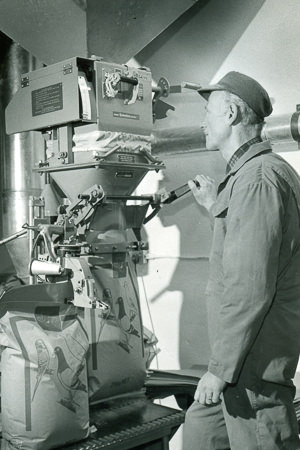




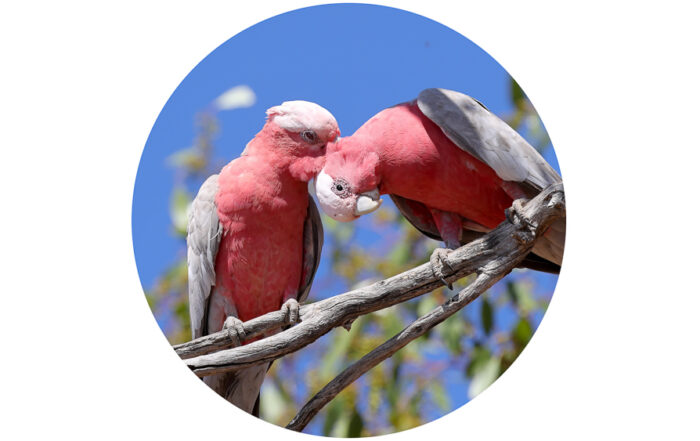


Leave A Comment